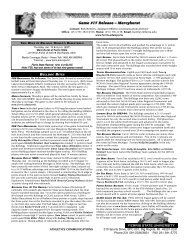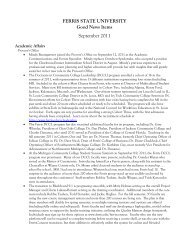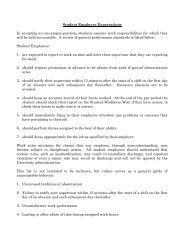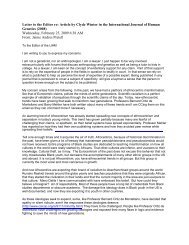Tavia Nyong'o Racial Kitsch and Black Performance - Ferris State ...
Tavia Nyong'o Racial Kitsch and Black Performance - Ferris State ...
Tavia Nyong'o Racial Kitsch and Black Performance - Ferris State ...
Create successful ePaper yourself
Turn your PDF publications into a flip-book with our unique Google optimized e-Paper software.
fore Manray is kidnapped by the Mau Mau).This seems to be because,<br />
while authenticity is subject to a great deal of skepticism in Bamboozled,<br />
the shamefulness of inauthenticity is never questioned.The film’s<br />
phobia for Pierre Delacroix is total. He has ab<strong>and</strong>oned his name, his<br />
language, his family, his race, even his manhood (as is shown in his<br />
treatment of women). Depicted with over-the-top glee by comic actor<br />
Damon Wayans, who uses the effeminate mannerisms he perfected<br />
in parodying a gay film reviewer on the television series In Living<br />
Color, Delacroix is the film’s internal scapegoat, one upon whom we<br />
can credibly lay blame, <strong>and</strong>, therefore, additional violence. The odd,<br />
excessive repetition of carnage, in which Delacroix’s death avenges the<br />
death of the Mau Mau (which is society’s vengeance for their murder<br />
of Manray), shows that the film cannot find a way to exit the circuit<br />
of ‘an eye for an eye.’<br />
Conclusion: Becoming Modern, Becoming Innocent<br />
The curating or ownership of racist kitsch is confounding to those<br />
who would rather forget it ever occurred.Thus, a film like Bamboozled<br />
is seen by some as “heavy-h<strong>and</strong>ed satire,” an “endless polemic” that is<br />
only barely “endurable.” For Leonard Maltin, the author of these judgments,<br />
to remember the racism within innocent pleasures is already to<br />
be polemical. 36 To pollute the American popular film—a form centered,<br />
as Richard Dyer argues, upon the romantic utopia of a white<br />
heterosexual couple in three-point lighting—with blackface is simple<br />
resentment. Twentieth-century postmodernity in the United <strong>State</strong>s<br />
racial imagination is structured by a wish to move beyond <strong>and</strong> forget<br />
the scapegoating of blacks. Becoming modern involves the seemingly<br />
impossible task of becoming innocent, a project that in its more academic<br />
formulations announces itself as “post-race.”<br />
Manthia Diawara’s provocative essay accompanying photographs of<br />
racist kitsch by David Levinthal discusses this difficulty with uncommon<br />
skill. 37 His comprehensive analysis of the visual <strong>and</strong> material culture<br />
of racist kitsch, <strong>and</strong> the specific resignifications that Levinthal’s art<br />
photography works upon them, ends in an ambivalent anecdote regarding<br />
an interaction with his thirteen-year old son, who innocently<br />
happens upon him as he is examining the photographs. His son’s indifferent<br />
response to the images, Diawara reports, “is challenging me<br />
to stop being the custodian of these stereotypes, to distance myself<br />
from them, <strong>and</strong> to begin enjoying the humor in them. Only then will<br />
I, like him, become an individual <strong>and</strong> modern.” 38<br />
Diawara’s essay thus ends by taking the willfully ironic stance of an<br />
achieved innocence. Becoming modern means becoming innocent, a<br />
process that seems available only through the enlarging <strong>and</strong> revivifying<br />
energies of a child. Diawara’s enjoyment of his son’s insouciance—<br />
tavia nyong’o 387

















